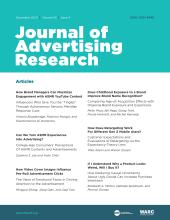Abstract
Consumers are increasingly exposed to advertising aimed at producing positive reactions toward goods that do not meet aesthetic marketplace standards, such as oddly shaped produce. In this paper, the authors posit that one of the reasons why consumers reject these aesthetically unexpected goods is because they lack a certain causal explanation, which can be clearly communicated through advertising. In four studies, including a field study, consumers exhibited higher preference for aesthetically unexpected goods when advertisements featured low causal uncertainty (i.e., few causes), particularly in comparison with when no causal information was provided. This effect occurred regardless of cause type (human versus natural).
- Aesthetically unexpected goods
- advertising
- causal uncertainty
- sustainability
- point-of-purchase marketing communications
- unexpected advertising
- Received December 28, 2022.
- Received (in revised form) August 12, 2023.
- Accepted August 17, 2023.
- Copyright © 2023 ARF. All rights reserved.
ARF MEMBERS
If you are a member of the Advertising Research Foundation, you can access the content by logging in here
Log In
Pay Per Article - You may access this article (from the computer you are currently using) for 30 days for US$20.00
Regain Access - You can regain access to a recent Pay per Article purchase if your access period has not yet expired.





